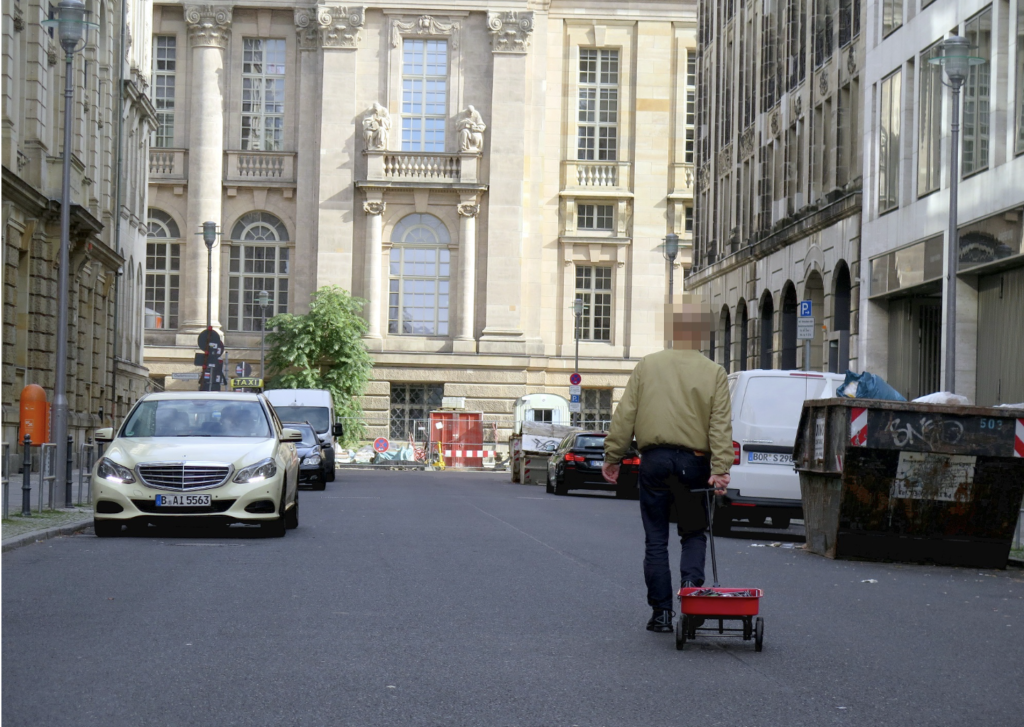Artists Can Expose The Reality Behind AI
Apr 8, 2024 | Pratirodh Bureau
Simon Weckert used 99 smartphones and a little red wagon to trick Google Maps into reporting a “traffic jam” (Image: Simon Weckert)
There’s no need to read a lengthy academic paper to understand the shortcomings of Artificial Intelligence.
You can just look to the work of Berlin performance artist Simon Weckert.
In 2020, Weckert tricked Google Maps by creating a “virtual traffic jam”. He gathered 99 smartphones and piled them into a red wagon, then walked back and forth for hours on a street in Berlin, which falsely signalled gridlock.
Within an hour, the typically bustling motorway became desolate — with Google re-routing commuters to other routes to avoid the “congestion”.
Without tech-speak or algorithmic adjustments, the artist elegantly communicated the complex technological limitations of technology.
Weckert’s work speaks to the long history of excellence in artists’ critique of society.
The arts community has the ability to connect to the wider public in a way many academics and so-called tech experts struggle.
Amid the AI revolution, artists are uniquely well-positioned to communicate the impacts and shortcomings of AI on our lives — just as Weckert did with his “Google Maps Hack”.
What artists can do
What human-driven art does, and can do, is help us all better question and critically think about the limitations of AI.
In Weckert’s example, it was his human observational skills of a protest that led him to make connections about an otherwise notoriously opaque technology: During the protest, a traffic jam was signalled. Weckert wondered whether it was the phones in the protester’s pockets that led to inaccuracy — and decided to make an artistic expression to illustrate this observation.
The arts have a long history of doing this — from Pablo Picasso, who “viewed art as a powerful tool for societal reform and used his works to confront and challenge prevailing political and social conditions”; to Banksy, who uses street art to challenge socio-political norms; to Chinese artist Ai Weiwei, whose political critiques have led to social change in China and globally.
What these artists do, which AI cannot, is integrate concepts, ideas and experiences — and draw together complexity and uncertainty — in order to challenge us to see a different perspective.
What AI can’t do
AI is missing an important component of what many in the arts world consider vital: lived experience.
In Ai Weiwei ‘s view, “life is art, art is life”. AI doesn’t have a life, which is a major limitation on its ability to truly create art through experience.
In a recent New Yorker article, staff writer Kyle Chayka points out how AI fails at the ” classic exercise” of drawing hands typically assigned to beginners. While the average human also struggles to draw hands well, many of us can do better than the multi-number and dissociated hands we see in AI-generated images through observation and practice.
Humans have an amazing feature where our brains fill in “gaps”. For example, those with macular degeneration, which impairs vision, experience what is known as “perceptual filling in,” whereby the brain fills in the visual gaps.
Our brains picture what a hand looks like in all sorts of contexts, even if we can only see one angle at a time. We understand that the part of the hand not visible from a single perspective is indeed still present in the real world, and our human brains account for this visual “gap” based on our lived experiences.
But AI cannot. Instead, AI hallucinates — filling the gaps in with artificial nonsense.
AI doesn’t manage “uncertainty” as we humans do because AI is disembodied from the world.
What AI ‘art’ has done so far is generate homogenised and uniform images based on its programmed parameters.
This has led to quite an impact in the advertising world.
AI image renderings are regularly mocked — as was the case with the recent advertisement used to entice listeners to attend the Queensland Symphony orchestra. The ad, interestingly, caused quite a stir because of the unusual hands in the AI-generated image.
AI shines a light on human prejudices
Artists often make their work accessible — both in terms of the spaces in which they create their work, and the way in which the messages are communicated.
Consider Banksy’s art: it occupies the streets that everyone walks on, and uses images that cut across language. On a single brick wall with only the words “Another world is possible“, Banksy uses imagery to challenge people to (re)consider the role of technology.
In contrast, what AI image rendering appears to be doing exceptionally well is magnifying humans’ biases and faults.
It has been demonstrated that the (human-generated) material on which the AI is trained perpetuates ageism, sexism, racial bias, and classism. It’s no surprise, then, that AI image generators have portrayed attractive people as young and light-skinned.
AI’s skillset appears to be inadvertently shining a light on our prevailing human societal norms and prejudices.
Human artists are uniquely placed to communicate the real implications of AI’s overhyped and non-existent understanding of the world, and inspire us to question and re-evaluate our own human blind spots.
With growing evidence that the arts and humanities can support us to effectively engage our critical thinking and curiosity, the artistic community may be the inspiration that humanity needs to pull back the proverbial curtain on the reality of AI.
(Originally published under Creative Commons by 360info™. Read the original article here)
